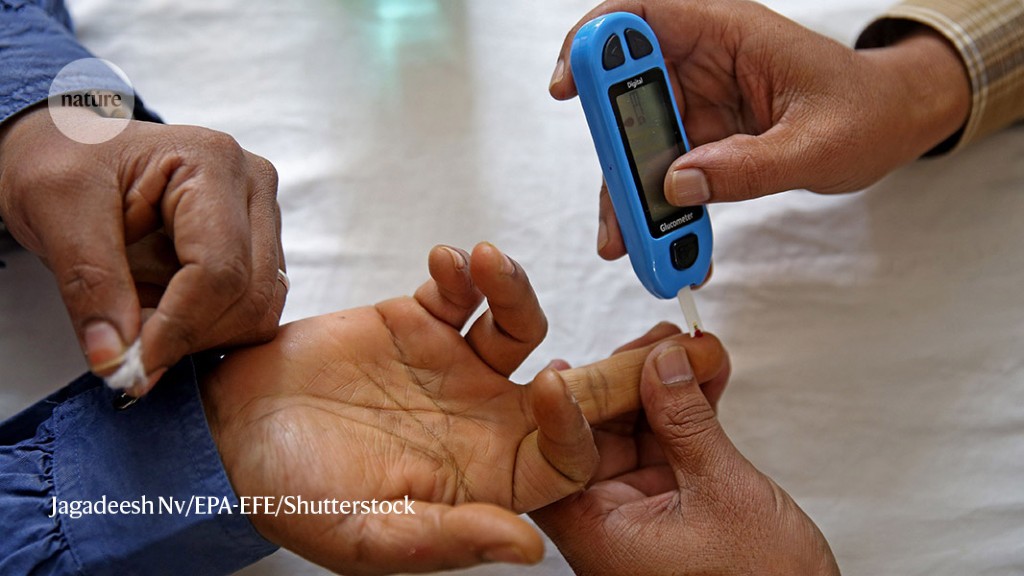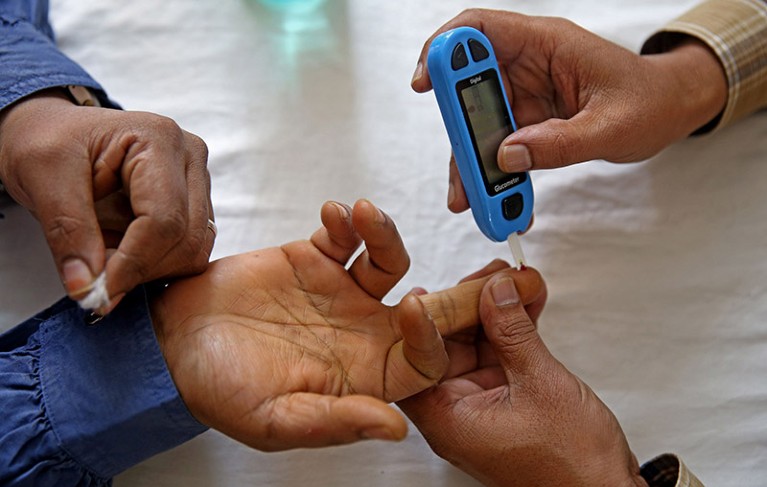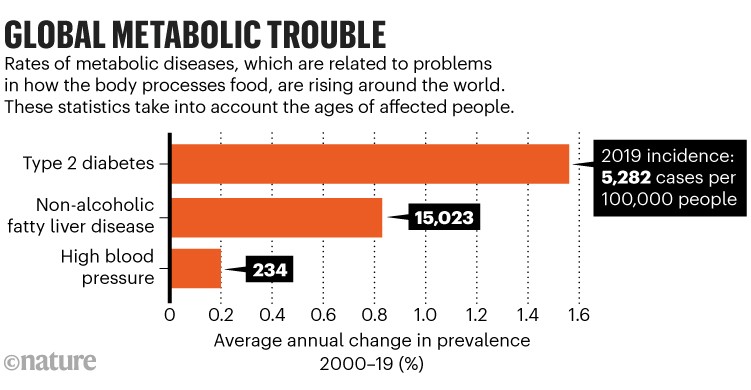Blood-sugar testing. The global prevalence of type 2 diabetes is increasing.Credit: Jagadeesh Nv/EPA-EFE/Shutterstock
Type 2 diabetes and related metabolic diseases are on the rise worldwide, and some of the world’s poorest people are bearing the brunt, a study shows1.
The research, published in Cell Metabolism on 7 March, reports rising rates not only of diabetes but also of high blood pressure and obesity-linked liver disease. All three conditions are caused by problems with metabolism — the process of breaking down food into energy. And all three grew in prevalence between 2000 and 2019; for example, the prevalence of type 2 diabetes grew more than 1.5% annually in that time period (see ‘Global metabolic trouble’). The study also reports that obesity and high blood cholesterol levels are creating huge health burdens worldwide, with 5 million and 4.3 million deaths attributable to these conditions respectively in 2019.
Source: Ref 1.
To understand the global scope of metabolic disease, cardiologist Nicholas Chew at the National University Health System in Singapore and his colleagues reanalysed results from the Global Burden of Disease, Injuries, and Risk Factors Study 20192, a compilation of mortality data from more than 200 countries. The authors found that from 2000 to 2019, the number of years of healthy life lost because of obesity increased by about 0.5% per year. The number of deaths and the years of healthy life lost owing to type 2 diabetes also increased, by about 0.08% and 0.77% per year, respectively, despite programmes in many countries aimed at limiting diabetes and obesity. “That’s a cause for concern,” Chew says.
Adding to the burden, these diseases “don’t often occur in isolation”, says study co-author Mark Muthiah, a gastroenterologist also at the National University Health System. Rather, they have shared causes and one person will often experience more than one condition.
The team also found that the amount of healthy life lost to obesity is rising in low- to middle-income countries, whereas rates are dropping in high and high-middle-income countries. There’s “no doubt” that income inequality exacerbates the burden of metabolic diseases, says hepatologist Zobair Younossi at the Inova Fairfax Medical Campus in Virginia. Lack of access to health care, healthy food and exercise are not the only drivers of metabolic disease, but they are significant risk factors. In many parts of the world, if “you want to eat healthy — it’s expensive”, Muthiah says.
Controversial estimates
Other researchers agree that the prevalence of metabolic diseases is on the rise, mostly because diets have become heavier in highly processed foods — which often contain lots of sugar and refined grains — and the amount of exercise many people get is declining. But most people who have metabolic diseases “die of cardiovascular disease, renal diseases and even cancers instead of these conditions per se”, says obesity epidemiologist Frank Hu at Harvard University in Cambridge, Massachusetts. That makes it difficult to estimate the death rates attributable to metabolic disease, and gives Hu pause when it comes to the values put forward in the latest study.
How a pioneering diabetes drug offers hope for preventing autoimmune disorders
Younossi is sceptical of the authors’ finding that the amount of death and disability caused by non-alcoholic fatty liver disease, which is linked to obesity, is falling. Younossi says that researchers involved in the original Global Burden of Disease study lumped all liver diseases together for analysis. He thinks that declines in death and disability in that category were probably driven not by changes in fatty liver disease but by changes in viral hepatitis, an infectious liver disease that has been successfully targeted by public-health campaigns.
“I don’t disagree with him,” Muthiah says. Generating disease estimates on a global scale inherently involves compromises, especially for places where access to health care is limited. “You’re going to have to accept some limitations on the granularity of the data,” he says.
Growing burden
Despite disagreement over the precise statistics, scientists are united in worrying that the numbers are heading in the wrong direction. As diets continue to shift towards highly processed foods, “the prevalence of obesity will continue to increase, which will drive up obesity-related conditions”, Hu says. “This will have serious public-health and economic consequences globally.”
Muthiah and his co-authors hope to help avert this outcome by bringing attention to the need for quality health care for people who are at risk. “If we can improve access to care, we can limit the burden of metabolic diseases in the future,” Muthiah says.










More News
Old electric-vehicle batteries can find new purpose — on the grid
Finding millennia-old ‘monumental’ corals could unlock secrets of climate resilience
Argentina’s pioneering nuclear research threatened by huge budget cuts